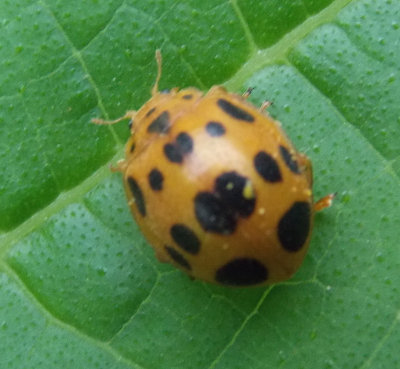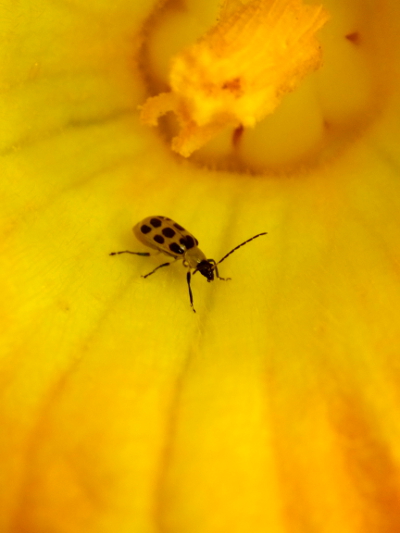
Beetles on squash
 Even though I use the lower-work strategies I outline in The Naturally Bug-Free Garden to deal with pests on cucurbits, I do crush bad bugs there if they hang around while I'm taking photos or harvesting.
Even though I use the lower-work strategies I outline in The Naturally Bug-Free Garden to deal with pests on cucurbits, I do crush bad bugs there if they hang around while I'm taking photos or harvesting.
The beetle to the left
was clearly a bad bug since it was sitting on a nibbled section of leaf,
so I smashed it...then went inside to look the beetle up. I
learned that squash beetles (Epilachna borealis) are actually ladybugs, as are Mexican bean beetles.
Despite their illustrious heritage, though, these are beneficials gone
bad --- both species are leaf eaters in all stage of their life
cycle. To tell squash beetles apart from good ladybugs, look for
the orange color and for the seven big black spots on each wing cover
(i.e. on each half of the back).

Spotted cucumber beetles (Diabrotica undecimpunctata howardi)
are also on the bad list, although the beetles I saw this weekend were
inside squash flowers and might have been acting as minor
pollinators. (Makes me want to do a series of photographs entitled
"What Georgia O'Keefe left out of her paintings.")
Since cucurbits are
native to the Americas, they tend to feed more pest insects than many of
our other vegetables. In addition to the ones shown here, you're
likely to find squash bugs, squash vine borers, and striped cucumber
beetles in your planting, and might also stumble across other cucumber
beetles, corn rootworms, melonworms, pickleworms, armyworms, cutworms,
leafminers, seedcorn maggots, tarnished plant bugs, aphids, leafhoppers,
thrips, mites, and sap worms eating various parts of your plants.
Phew! Sometimes it's a wonder gardeners have excess zucchinis to
foist off on their neighbors at this time of the year.
Want more in-depth information? Browse through our books.
Or explore more posts by date or by subject.
About us: Anna Hess and Mark Hamilton spent over a decade living self-sufficiently in the mountains of Virginia before moving north to start over from scratch in the foothills of Ohio. They've experimented with permaculture, no-till gardening, trailersteading, home-based microbusinesses and much more, writing about their adventures in both blogs and books.
Want to be notified when new comments are posted on this page? Click on the RSS button after you add a comment to subscribe to the comment feed, or simply check the box beside "email replies to me" while writing your comment.

I love your curiosity & desire for knowledge.
Your last sentence is key: Nature is usually in balance and it's only the commercial farmers who need to squeeze every last fruit out of their fields for Profit's sake.
The pioneer farmers used to plant corn by hand in hills, four seeds to a hill. "One for the bird; one for the worm; one for the rust; and one for me."